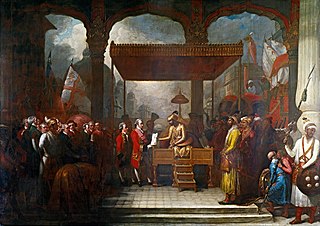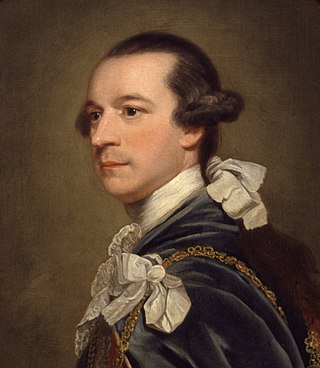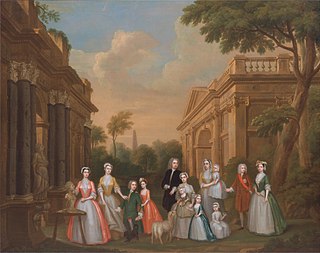Contents
Other years |
| Countries of the United Kingdom |
| Scotland |
| Sport |
| 1765 English cricket season |
Events from the year 1765 in Great Britain.
Other years |
| Countries of the United Kingdom |
| Scotland |
| Sport |
| 1765 English cricket season |
Events from the year 1765 in Great Britain.


1765 (MDCCLXV) was a common year starting on Tuesday of the Gregorian calendar and a common year starting on Saturday of the Julian calendar, the 1765th year of the Common Era (CE) and Anno Domini (AD) designations, the 765th year of the 2nd millennium, the 65th year of the 18th century, and the 6th year of the 1760s decade. As of the start of 1765, the Gregorian calendar was 11 days ahead of the Julian calendar, which remained in localized use until 1923.

Charles Watson-Wentworth, 2nd Marquess of Rockingham, was a British Whig statesman and magnate, most notable for his two terms as prime minister of Great Britain. He became the patron of many Whigs, known as the Rockingham Whigs, and served as a leading Whig grandee. He served in only two high offices during his lifetime but was nonetheless very influential during his one and a half years of service.

George Grenville was a British Whig statesman who rose to the position of Prime Minister of Great Britain. Grenville was born into an influential political family and first entered Parliament in 1741 as an MP for Buckingham. He emerged as one of Cobham's Cubs, a group of young members of Parliament associated with Lord Cobham.

William Henry Cavendish Cavendish-Bentinck, 3rd Duke of Portland, was a British Whig and then a Tory politician during the late Georgian era. He served as chancellor of the University of Oxford (1792–1809) and as Prime Minister of Great Britain (1783) and then of the United Kingdom (1807–1809). The gap of 26 years between his two terms as prime minister is the longest of any British prime minister. He was also the fourth great-grandfather of King Charles III through his great-granddaughter Cecilia Bowes-Lyon, Countess of Strathmore and Kinghorne.

William Petty Fitzmaurice, 1st Marquess of Lansdowne,, was an Anglo-Irish Whig statesman who was the first home secretary in 1782 and then prime minister from 1782 to 1783 during the final months of the American War of Independence. He succeeded in securing peace with America and this feat remains his most notable legacy.

The American Colonies Act 1766, commonly known as the Declaratory Act, was an Act of the Parliament of Great Britain which accompanied the repeal of the Stamp Act 1765 and the amendment of the Sugar Act. Parliament repealed the Stamp Act because boycotts were hurting British trade and used the declaration to justify the repeal and avoid humiliation. The declaration stated that the Parliament's authority was the same in America as in Britain and asserted Parliament's authority to pass laws that were binding on the American colonies.

Marquess of Rockingham, in the County of Northampton, was a title in the Peerage of Great Britain. It was created in 1746 for Thomas Watson-Wentworth, 1st Earl of Malton. The Watson family descended from Lewis Watson, Member of Parliament for Lincoln. He was created a Baronet, of Rockingham Castle in the County of Northampton, in the Baronetage of England in 1621. In 1645 he was further honoured when he was raised to the Peerage of England as Baron Rockingham. The third Baron served as Lord-Lieutenant of Kent. In 1714 he was created Baron Throwley, Viscount Sondes and Earl of Rockingham in the Peerage of Great Britain. His eldest son Edward Watson, Viscount Sondes, predeceased him and he was succeeded by his grandson, the second Earl. The second Earl was Lord-Lieutenant of Kent before his early death in 1745. He was childless and was succeeded by his younger brother, Thomas. He had previously represented Canterbury in Parliament.
The Rockingham Whigs in 18th-century British politics were a faction of the Whigs led by Charles Watson-Wentworth, 2nd Marquess of Rockingham, from about 1762 until his death in 1782. The Rockingham Whigs briefly held power from 1765 to 1766 and again in 1782, and otherwise were usually in opposition to the various ministries of the period.

Earl Fitzwilliam was a title in both the Peerage of Ireland and the Peerage of Great Britain held by the head of the Fitzwilliam family.

The Grenville Whigs were a name given to several British political factions of the 18th and the early 19th centuries, all of which were associated with the important Grenville family of Buckinghamshire.

General Charles FitzRoy, 1st Baron Southampton was a British Army officer who served in the Seven Years' War and a politician who sat in the House of Commons from 1759 to 1780. The second son of Lord Augustus FitzRoy, FitzRoy joined the 1st Foot Guards as an ensign in 1752 and was promoted to lieutenant-colonel in 1758. In the following year he fought at the Battle of Minden as an aide de camp, where he was a part of the controversy surrounding Lord George Sackville's slow reaction to orders sent to him. FitzRoy was also present at the Battle of Vellinghausen in 1761. Having been quickly promoted through the ranks with the support of his powerful family, he was promoted to major-general in 1772 and became a general in 1793.

Charles William Wentworth Fitzwilliam, 5th Earl Fitzwilliam in the peerage of Ireland, and 3rd Earl Fitzwilliam in the peerage of Great Britain, was a British nobleman and politician. He was president three times of the Royal Statistical Society in 1838–1840, 1847–1849, and 1853–1855; and president of the British Association for the Advancement of Science in its inaugural year (1831–2).

Whistlejacket is an oil-on-canvas painting from about 1762 by the British artist George Stubbs showing the Marquess of Rockingham's racehorse approximately at life-size, rearing up against a plain background. The canvas is large, lacks any other content except some discreet shadows, and Stubbs has paid precise attention to the details of the horse's appearance. It has been described in The Independent as "a paradigm of the flawless beauty of an Arabian thoroughbred". The Fitzwilliam family, heirs of the childless Rockingham, retained the painting until 1997 when funding from the Heritage Lottery Fund allowed the National Gallery, London to acquire it for £11 million.
Events from the year 1766 in Great Britain.
Events from the year 1770 in Great Britain.
Events from the year 1730 in Great Britain.
Events from the year 1782 in Great Britain. The American Revolutionary War draws to a close.

Thomas Watson-Wentworth, 1st Marquess of Rockingham, KB, PC (I) of Wentworth Woodhouse, Yorkshire was a British Whig politician who sat in the House of Commons from 1715 until 1728 when he was raised to the Peerage as Baron Malton.

The first Rockingham ministry was a British ministry headed by the Marquess of Rockingham from 1765 to 1766 during the reign of King George III. The government was made up mainly of his followers known as the Rockingham Whigs. The most influential member of the government was the Duke of Newcastle, a former Prime Minister, who served as Lord Privy Seal. It is often referred to as the only government ever to have been made up almost entirely of members of the Jockey Club, with Rockingham himself being a prominent patron and follower of the turf. Rockingham was noted for his ignorance of foreign affairs, and his ministry failed to reverse the growing isolation of Britain within Europe.
Mary Watson-Wentworth, Marchioness of Rockingham was the wife of Charles Watson-Wentworth, 2nd Marquess of Rockingham, who was prime minister of Great Britain in 1782 and again from 1765 to 1766.